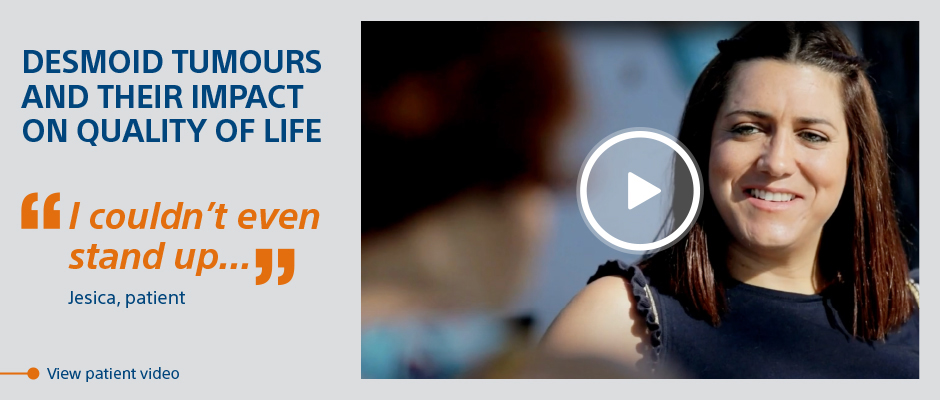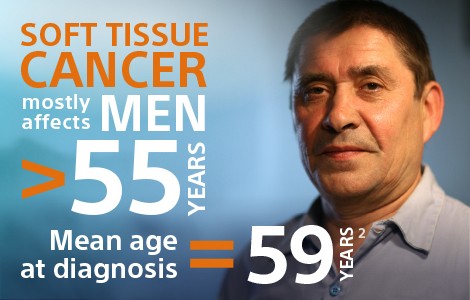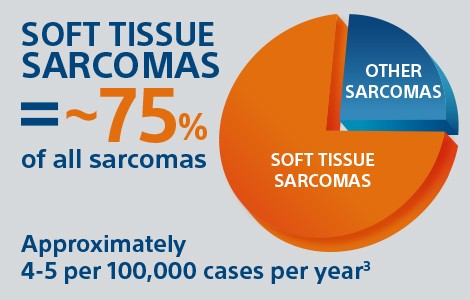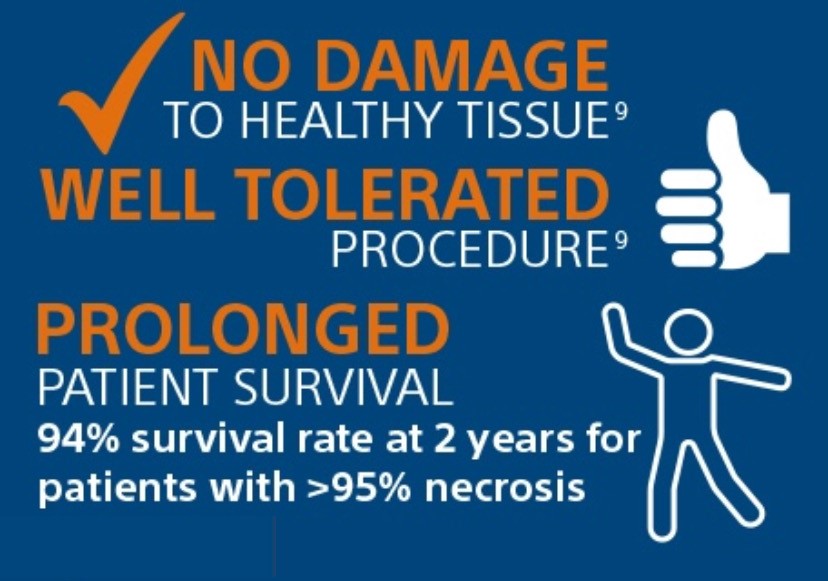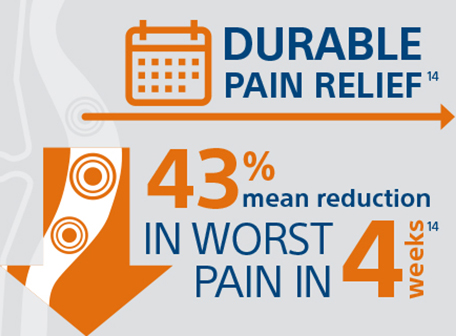Medical Specialties > Interventional Radiology > Ablation Solutions > Cryoablation Indications > Soft Tissue Tumours
Soft Tissue Tumours
Soft-tissue sarcomas (STS) are rare tumours, with at least 50 known subtypes. In adults, malignant cells are formed inside the so-called soft tissue of the organism, such as muscles, connective tissue, blood or lymphatic vessels, nerves, ligaments and adipose tissue, and can occur in practically any part of the body.1
The most common STS types are Liposarcomas and Leiomyosarcomas (LMSs), with an incidence <1/100,000/year each. 3
Subtypes
Tumour Subtype |
Incidence (per 100,000 per year) |
Description |
Use of CA |
|
Myosarcoma |
Leiomyosarcoma (malignant) |
0.79A |
•Arise from smooth muscle cells and account for ~10-20% of all soft tissue sarcomas; most commonly found in the uterus, abdomen or pelvis of adultsB,C
|
Relevant to a wide range of soft tissue sarcoma subtypes (overall incidence 4-5/ 100,000)D •Retrospective studies/ case reports support use of CA as an alterative to surgery, or as a Tx option for recurrent disease (with curative intent)E,F,G
•Studies also support use of CA for pain palliation in recurrent/ metastatic diseaseG,H,I
|
Rhabdomyosarcoma (malignant) |
0.22A |
•Develop in the skeletal or voluntary muscles, most commonly in the head and neck, but can also occur in the abdomen; most likely to affect children/adolescentsA,B
|
||
Liposarcoma (malignant) |
0.51A |
•Develop from adipose cells and occur anywhere throughout the body but usually on the trunk, limbs and in the retroperitoneum; most common in adultsB,C
|
||
Desmoid-Type Fibromatosis (Desmoid Tumours) (intermediate - locally aggressive) |
0.2-0.4J,K |
•Develop in the fibrous tissues and can affect nearly all parts of the body (extremities – including pelvic & shoulder girdles, trunk – mostly abdominal wall, and abdominal cavity – mostly within the mesentery of the pelvis); most common in adolescents and young adults, with a high recurrence rate (20-30%)J,K
|
•CA included in ESMO guidelines as an option for recurrent extra-abdominal casesL,M
•Some studies also support use of CA as a 1L TxN,O
|
|
Abdominal Wall Endometriosis (AWE) (benign) |
2.57 (~1% c-sections per year)*P |
•A rare form of extra-pelvic endometriosis, with the majority of cases occurring following caesarean section or abdominal surgeryQ
|
•Mayo Clinic indicates that CA is emerging in the Tx algorithm for AWE (precise ice ball visualization, minimal intraprocedural and post-procedure pain); case reports also support useP,Q,R
|
|
Nerve Tumours |
Neurofibromas/ Schwannomas (benign) |
1.2 (Neurofibromatosis type 1)S 1.09 (Vestibular schwannomas)T |
•Neurofibroma is a type of nerve tumour that forms soft bumps on or under the skin. It affects mostly adults in their 20’s to 40’s.U
•Schwannoma develops from Schwann cells, which protect and support the nerve cells of the nervous system. It can affect people of all ages.V
|
•A recent research includes as a possible alternative treatment option for non-cutaneous PNSTs, mainly benign neurofibromas.W, X
•An article reports a pediatric case of CA as a successful treatment for a plexiform schwannoma near the spinal cord (on a 3-years-old patient), after surgical attempts failed.Y
•Some latest clinical evidences insert Cryoanalgesia as a safe/low risk procedure for pain palliation of peripheral nerve sheath tumours.Z
|
Peripheral nerve sheath tumour (MPNST) (malignant) |
0.3 – 0.5B |
|||
Synovial sarcoma (malignant) |
1-2 per million (USA)BB |
•Synovial sarcomas are approximately 10% of all soft tissue sarcomas. They develop in cells around joints and tendons an are more common in young adults, but can also develop in children.B
|
•A case study assess the safety and efficacy of CA for palliation and local tumour control in the pediatric/young adult population.CC
|
|
GIST(Gastrointestinal Stromal Tumor) (malignant) |
1-1.5DD,EE |
•GIST is a type of cancer in the gastro-intestinal tract, which starts from cells in connective tissues; it develops most commonly in the stomach (50-70%) and in the small intestine (20-30%) and it usually affects adults in their 55’s to 65’s.EE
|
•A case study demonstrates how the CA therapy was successfully used on a 69-year-old man to treat esophageal GISTs.FF
|
|
Retroperitoneal sarcoma (malignant) |
0.3-0.4GG |
•Retroperitoneal soft tissue sarcomas (RPSs) are neoplasms that originate in the retroperitoneum. They usually affect adult men in their 60’s, but can occur in almost any age group.HH
|
•A recent study demonstrates that minimally invasive percutaneous CA is a safe and efficient treatment for recurrent RPSs.II
|
|
Treatment options



The treatment of Soft Tissue Sarcomas are often "multi-modal”, meaning that it is usual to combine different therapy modalities in incremental, alternating, and sometimes simultaneous ways. The most common treatments are:5,6
- External beam RT (EBRT)
- Surgery
- Chemotherapy
- Targeted Drug Theraphy
- Radiofrequency Ablation
- Cryoablation
Clinical Results – Why Cryoablation?
Discover Cryoablation for Soft Tissue
“Cryoablation offered complete and durable tumour destruction,without damaging surrounding organs.”
Dr Xavier Buy, Bergonié Institute of Oncology, Bordeaux, France
Recent studies show that percutaneous Cryoablation could be an effective alternative option to surgery for soft tissue tumours. Indeed, it can not only represent a salvage treatment for both benign and malignant primary soft tissue cancer with curative intent but, thanks to its minimally invasive nature, it is also easy to perform, safe and repeatable.7,8
Defeat the pain with Cryoablation!
“Percutaneous ablation of MSK metastases may result in significant pain palliation, prevention of morbidity from skeletal-related events, and local tumor control. This minimally invasive approach has unique advantages compared with surgery or radiation therapy.”
Kurup AN et al. 2017
The effectiveness of Cryoablation for palliating pain from cancer metastasis has been reported by many studies12 (i.e. Motion Study); this is also true for Soft Tissue tumours.
Indeed, the Cryoablation treatment seems to be very effective in reducing local pain for recurrent Soft Tissue Sarcoma (RPSs in particular)13 and achieving local tumour control.14,15
Our Solutions
Cryoablation is a minimally invasive treatment that uses extreme cold to freeze and destroy diseased tissue, including cancer cells. We offer a comprehensive portfolio of advanced Cryoablation systems and needles to optimise the efficacy and versatility of Cryoablation across a variety of indications.
Learn more about our solutions
CAUTION: The law restricts these devices to sale by or on the order of a physician. Indications, contraindications, Warnings and instructions for use can be found in the product labelling supplied with each device. Information for the use only in countries with applicable health authority product registrations. Material not intended for use in France.
















